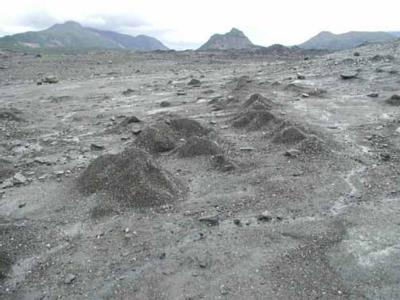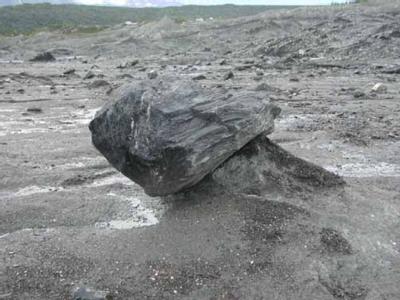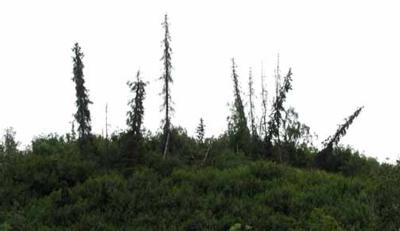16 July, 2000
July 16, 2000
Matanuska Glacier, Alaska
After a beautiful day yesterday the foul weather is back with us. Since
Ben and I had nothing to do today most of the day was spent helping
Justin and Cashman with their daily tasks. Tonight we will get to
discuss our dye tracing project with Jeffrey Strasser and tomorrow we
ought to begin that phase of our project.
There are certain features that I’ve seen around this glacier that are
really interesting. One of these is something called an “ice cone”. When
I first saw one of these it simply looked like a pile of very small
stones. In some areas where the debris field gets pretty thin you can
see numerous ice cones in close proximity to each other. I might not
have known that they weren’t just small stone piles if Justin hadn’t
pointed them out to me one day. Suppose you spread a pile of very small
stones in a one foot diameter circle on top of a layer of ice, mounding
it so there’s some point elevated above the rest. Outside this area of
stone the sun is in direct contact with the ice and will melt it. At the
edges where it’s thin the stones will actually absorb sunlight to
accelerate the melting . But as you move to the thicker layers the
sun-warmed stones are no longer in contact with the ice. Rather, the
stones below are shaded from the sun. As the thickness increases the ice
becomes more insulated from the sun and the amount of melting will
decrease. The result is it ends up melting fastest around the edges and
slowest wherever the layer is thicker, and a cone-shaped piece of ice
covered with stones develops.
On a similar note there are large rocks and boulders perched at a
variety of angles on pedestals of ice. Just as thick layers of small
stones can shield and insulate the ice from the sun’s melting radiation,
so do larger pieces of rock. The ice around the rock melts in the direct
sunlight. In addition, due to the angle and path of the sun during the
day, more ice is melted away from the south side under the rock than the
north and so eventually the rock begins to tilt toward the south. Soon
the tilt is steep enough that the rock may slide down the surface of the
ice pillar. As a result these are called “sliding boulders” These
boulders slowly “walk” across the glacier, generally from north to south
as this cycle gets repeated over and over.
Another interesting thing to see is something called “drunken trees”. On
my first hike to North Vent Justin pointed these out to me. There was a
high, long ridge that passed by near North Vent and many of the trees
were tilted in all different directions. The north side of this glacier
has a lot of rock, sand and silt debris and vegetation has been growing
on it for many, many years. In this parcticular area there are spruce and
cottonwood among others. But they are growing on soils that have formed
on solid ice below. As the ice melts the surface constantly changes. If
you could watch it in fast-forward mode it might look like the masts of
sailboats docked in a harbor, constantly waving back and forth.
Apparently these trees tilt from side to side with the passage of time
and the melting of the ice beneath.
Everywhere you go you can see different effects of the sun on north or
south facing areas. There is a picture on my July 9 journal showing a
lot of flowers to the left and scattered flowers on the right. The south
facing slope has more direct sunlight hitting it and the ice beneath
melts much more quickly and the rocks, silt and vegetation slide down
the slope as you can see in that picture. Looking off to the distance in
the picture reveals more of the same. The sun is a very powerful force
on the glacier!
Marvin Giesting

A collection of ice cones. The tallest of these is under two feet.

This sliding boulder appears to be ready for a short step forward.

Drunken trees near North Vent.

Notice all the sliding boulders headed in the same direction. Lemmings???
Contact the TEA in the field at
.
If you cannot connect through your browser, copy the
TEA's e-mail address in the "To:" line of
your favorite e-mail package.
|
